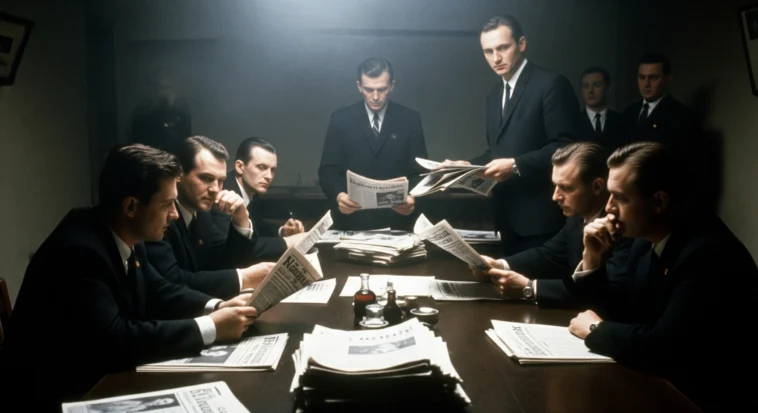
Fake news isn’t new—the Soviets were already masters of it during the Cold War.
The KGB used sneaky info tactics to mess with minds long before social media existed.
Today’s disinformation—from election lies to health hoaxes—still follows their old playbook. Knowing that history helps you spot the spin before it spreads.
Basically, the ghost of Soviet propaganda still slides into our digital DMs.
The Birth of Systematic Disinformation: KGB’s Information Warfare Arsenal
The Soviets didn’t just lie—they made lying into a full-on strategy.
They called it dezinformatsiya, and it wasn’t about loud, obvious propaganda.
It was sneaky. The goal? Confuse people, create doubt, and break trust between countries—especially in the West.
The KGB ran this like a pro team.
They didn’t toss out random fake stories. They planned every move like a chess game.
Ladislav Bittman, a former Czech intel officer who later flipped to the U.S., nailed it: disinformation was “a carefully constructed false message leaked into the enemy’s system.”
That’s the KGB vibe—smart lies in the right place at the right time.
- Read also: The Cold War’s Weirdest Spy Gadgets: A Peek into Espionage Ingenuity
- Read also: Divided World: Key Events of the Cold War
The 3 Main Moves in the KGB’s Disinformation Playbook
Faking documents
They made fake government memos, intelligence reports, and letters—super convincing ones. Sometimes even trained analysts couldn’t tell they were fake.
These forgeries would get “leaked” and spread like wildfire. Total chaos.
Hijacking the news
Instead of launching their own news sites, the KGB slid into existing ones.
They bribed or influenced journalists, fed them false stories, or used publications already leaning toward their views.
That way, the lies felt legit—because they came from trusted sources.
Spamming the lies everywhere
Once one outlet picked up the fake story, the KGB pushed it into other countries and news sources.
It created an echo. Same lie, different headlines. And the more people saw it, the more “real” it seemed.

Case Study: Operation INFEKTION and the AIDS Conspiracy
Let’s talk about one of the wildest—and scariest—disinformation wins of the Cold War: Operation INFEKTION. This was the KGB’s big play in the 1980s to spread the lie that the U.S. government made HIV/AIDS as a secret bioweapon.
Here’s how it went down:
In 1983, a pro-Soviet newspaper in India ran a letter from a “mystery American scientist” claiming AIDS was made at Fort Detrick—a real U.S. Army lab.
The KGB planted the story, then got Soviet and international media to pick it up like it was breaking news. Soon, the story spread to 80 countries.
People believed it. Some still do.
Why Operation INFEKTION Actually Worked?
It played on real fears
Bioweapons? Government secrets? Totally believable if you already don’t trust authority.
The KGB didn’t invent paranoia—they just stirred the pot.
It mixed truth with lies
Fort Detrick is a real lab. That made the fake stuff harder to dismiss.
Half-truths always hit harder.
It went global, fast
By bouncing the lie across different countries and news outlets, the story sounded legit.
“If everyone’s saying it, it must be true,” right?
It stuck around
The Soviet Union is long gone—but that AIDS conspiracy still pops up today.
That’s how deep this stuff can stick when it’s planted well.

The Digital Evolution
The KGB’s tricks didn’t die with the Cold War—they just went online.
Same playbook, new tech. Now it’s not forged papers—it’s tweets, memes, deepfakes, and bots.
Today’s disinfo game is faster, sneakier, and way harder to stop.
Why social media supercharges fake news
No Middleman needed
Back then, spies had to sneak lies into newspapers.
Now? Just hit “post.” Fake info can go straight to your feed, no editor required.
Algorithms love drama
Social apps boost stuff that gets clicks.
So the more wild or emotional the post, the more people see it—true or not.
Creepy targeting
Disinfo doesn’t spray everywhere. It zooms in—by location, age, interests, even political views.
You get fed the lie that hits you hardest.
Shared by real people
The KGB had to plant stories through secret agents.
Now, regular users do the dirty work for free. When your aunt shares a fake article, it feels legit—even if it’s not.
AI and Deepfake Technology
AI makes fake stuff 24/7
Bots can pump out thousands of fake comments, tweets, and articles that look human.
You can’t scroll fast enough to dodge them.
Deepfakes say what never happened
Now you can “see” a politician saying something they never said.
It’s fake—but it looks real. And people believe it.
Fake people, real problems
AI can create totally fake accounts with photos, posts, and followers.
These fake profiles then spread disinfo while pretending to be “just like you.”
Modern Russian Information Operations: The KGB Legacy Lives On
Russia didn’t leave disinformation in the past. They just gave it a tech upgrade.
The stuff the KGB did with faxes and forged papers?
Now it’s tweets, influencers, fake news sites, and slick videos. If the Cold War had TikTok, it’d look like this.
The Internet Research Agency (IRA)
The IRA ran 24/7 disinfo shifts during the 2016 U.S. election.
They built fake accounts, posted divisive memes, and stirred up drama online—all using old-school Soviet tactics, just plugged into social media.
And they’ve only gotten better (worse?):
How they do it now
Paying real influencers
Why fake a person when you can just pay a real one?
Russian ops now fund U.S. content creators—some don’t even know they’re part of a foreign disinfo campaign.
They just get paid to post stuff that pushes the Kremlin’s agenda.
Hollywood-level content
These aren’t grainy videos with bad lighting.
We’re talking pro-level editing, hired actors, custom graphics. It looks like real news, but it’s made to mislead.
Copy-paste news sites
They spoof legit news sites—same logos, same vibe, slightly different URL. You click thinking it’s real, but boom—it’s a fake pushing disinfo.
Who they target and why
Support for Ukraine
Russia wants the West to stop backing Ukraine.
So they spread lies about corruption, military failures, or how the war is wrecking other countries’ economies.
Elections
Same old strategy: stir up chaos. Spread fake news about voting.
Push conspiracy theories. Make people question if the system even works.
Public health
During COVID, Russian trolls went full anti-vax.
They flooded the internet with health hoaxes to make people doubt science and fight each other instead of the virus.

The Future of Information Warfare
The future of disinformation isn’t just more lies—it’s smarter, faster, and way more personal.
With AI and evolving social media tools, the tricks the KGB started are turning into full-blown mind games.
Here’s what’s coming:
Custom lies just for you
AI could learn your habits, fears, and favorite memes—and then use all that to send you fake news that feels real.
Like a Netflix algorithm, but for manipulating your brain.
Lies that learn on the fly
Machine learning might let fake news watch how people react—likes, shares, even fact-checks—and then instantly switch it up.
Basically, it’ll A/B test lies in real-time.
All-out multi-platform chaos
Instead of one fake post on one app, future disinfo will spread everywhere—Instagram, YouTube, TikTok, group chats, maybe even in-person events—all telling one big, coordinated lie from every angle.
- Read also: Heroes and Villains? 10+ Key Figures of the Cold War
- Read also: The Lion Roars: Winston Churchill in the Cold War
Final Thought: The KGB’s Playbook Still Haunts the Internet
The Cold War may be over, but the KGB’s fake news tricks live on—and now they’ve gone digital.
From Operation INFEKTION to deepfakes and AI bots, the old methods evolved into today’s info wars.
Tech makes it easier to share truth—but also easier to spread lies. So we need to stay sharp. Learn the history.
Question what you see. Think before you share.
The fight for truth isn’t new, but now it’s global, 24/7, and way more personal. If we want to protect democracy, we’ve got to win the battle for facts—one scroll at a time.



